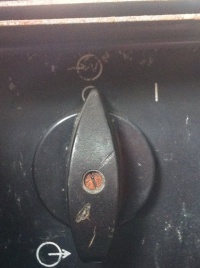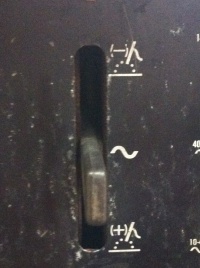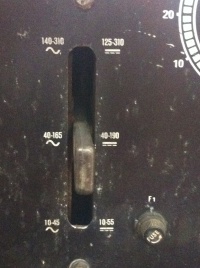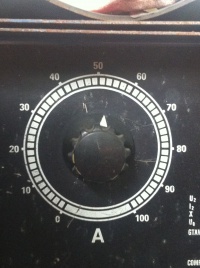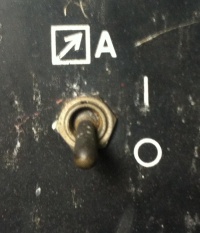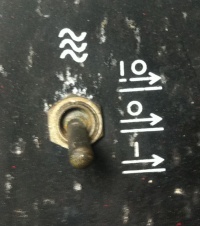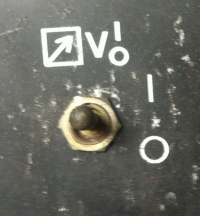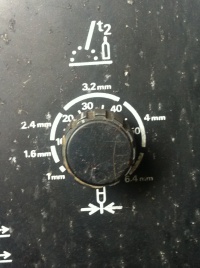TIG welder: Difference between revisions
No edit summary |
No edit summary |
||
| Line 9: | Line 9: | ||
==Capacity and rating == | ==Capacity and rating == | ||
The Tig welder has a large range | |||
== | ==Controls== | ||
Details on the front panel controls | |||
{| class="wikitable" | |||
|- | |||
! Name | |||
! Picture | |||
! Description | |||
|- | |||
| Main On Off Swtich || [[File:TIGWelderOn Off Switch.JPG|200px]] || Main switch on the welder, remember to turn off the welder as much as possible in-between setting up for welds | |||
|- | |||
| DC+ AC DC- selector || [[File:TIGWelderDC+ AC DC- Switch.JPG|200px]] || '''Do not change this setting with the main power switch ON.'''<br/> This selector has three positions that control the mode of the welder<br/> | |||
* DC- (DCEN), DC Electrode Negative, used for Steel TIG | |||
* AC, used for Aluminium TIG | |||
* DC+ (DCEP), DC Electrode Positive, used for Arc | |||
|- | |||
| Working power range selector || [[File:TIGWelderWorkingPowerRange.JPG|200px]] || '''Do not change this setting with the main power switch ON.''' <br/>There are three possible working ranges, low, medium and high. Each has a slightly different range for DC or AC | |||
{| | |||
! Position | |||
! AC | |||
! DC | |||
|- | |||
| Up || 140-310 || 125-310 | |||
|- | |||
| Middle || 40-165 || 40-190 | |||
|- | |||
| Down || 10-45 || 10-55 | |||
|} | |||
|- | |||
| Percentage power dail || [[File:TIGWelderPercentagePowerWithinRange.JPG|200px]] || Main power control dial, used to fine tune the amp control of the welder. <br/>This dial acts as a percentage of the current selected range. | |||
|- | |||
|Remote amp control enable||[[File:TIGWelderRemoteAmpageControlSwitch KEEPswitchedOFF.JPG|200px]] || Used to enable remote amperage control when a foot control is installed.<br/> '''Until we have a remote foot pedal this should be left in the OFF position.''' | |||
|- | |||
| High Frequency control || [[File:TIGWelderHF OnAtStrike Off Continous Switch.JPG|200px]] || Controls the high frequency generation of the welder, this switch has three positions and each has a set use.<br/> | |||
*Up (IO) High frequency start, use this for DC TIG welding (Steels) | |||
*Middle (O) Off used for Stick welding | |||
*Down (I) On, used to AC Tig welding (Aluminum) | |||
|- | |||
| Remote trigger enable || [[File:TIGWelderTorchSwitchEnable TIG-on STICKoff.JPG|200px]] || '''This should be left in the ON position.''' <br/> Used to enable the remote trigger, only place in OFF position when doing Arc welding | |||
|- | |||
| Gas overrun timer || [[File:TIGWelderGasOverrunTimer.JPG|200px]] || Controls how long after arc cut off the gas will run for. <br/> Outer scale is tungsten width, inner scale is time in seconds | |||
|} | |||
== | ==Tungsten and collets== | ||
We have a selection of the following tungsten tips and collets to fit | |||
===Grinding tip shapes=== | |||
== | ==Filler rods== | ||
We have the following stock of filler rods | |||
* Steel | |||
* Stainless steel | |||
* Aluminium | |||
* Copper | |||
== | ==Power supply == | ||
A 63A plug and socket connection is used, with a pushbutton on/off control station and no-volt release.<br/> | |||
RFID control of access will be installed shortly. | |||
== | ==Tig welding tips== | ||
Random collection of useful links | Random collection of useful links | ||
* http://www.mig-welding.co.uk/tig-technique.htm | * http://www.mig-welding.co.uk/tig-technique.htm | ||
* http://www.millerwelds.com/resources/improving-your-skills/tig/ | * http://www.millerwelds.com/resources/improving-your-skills/tig/ | ||
* http://www.mig-welding.co.uk/tig-calculator.htm | * http://www.mig-welding.co.uk/tig-calculator.htm | ||
[[Category:Tools_and_Equipment]] | [[Category:Tools_and_Equipment]] | ||
Revision as of 21:14, 8 June 2014
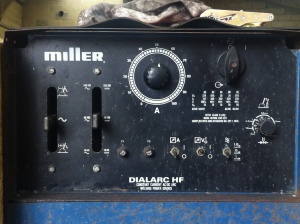
Miller Dialarc HF
TIG (Tungsten Inert Gas) welding is particularly useful for aluminium, It uses an electrode nozzle with a fixed (should be permanent, but they do wear) tungsten tip where a plasma 'flame' is created (started with a high-voltage / high freequency starter) and used to heat the filler wire and joint. The nozzle allows a flow of inert shield gas around the working area, reducing slag creation and (particularly important with aluminium) oxidation.
The TIG welder is a 'stick' welder - the electrode / nozzle is held in one hand, and the filler wire applied with the other.
Shield gas
For the TIG we use a Pureshield Argon.
Capacity and rating
The Tig welder has a large range
Controls
Details on the front panel controls
Tungsten and collets
We have a selection of the following tungsten tips and collets to fit
Grinding tip shapes
Filler rods
We have the following stock of filler rods
- Steel
- Stainless steel
- Aluminium
- Copper
Power supply
A 63A plug and socket connection is used, with a pushbutton on/off control station and no-volt release.
RFID control of access will be installed shortly.
Tig welding tips
Random collection of useful links
